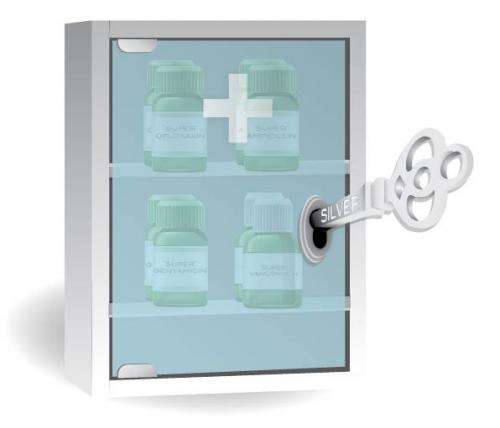A shot in the arm for old antibiotics: Silver boosts antibiotics

Slipping bacteria some silver could give old antibiotics new life, scientists at the Wyss Institute for Biologically Inspired Engineering at Harvard University reported June 19 in Science Translational Medicine.
Treating bacteria with a silver-containing compound boosted the efficacy of a broad range of widely used antibiotics and helped them stop otherwise lethal infections in mice. It helped make an antibiotic-resistant strain of bacteria sensitive to antibiotics again. And it expanded the power of an antibiotic called vancomycin that is usually only effective in killing pathogens called Gram-positive bacteria, such as Staph and Strep. Silver allowed vancomycin for the first time to penetrate and kill Gram-negative bacteria, a group that includes microbes that can cause food poisoning and dangerous hospital-acquired infections.
Silver also proved useful for two types of stubborn infections that usually require repeated rounds of antibiotic treatment and multiple visits to the clinic: dormant bacteria that lie low during antibiotic treatment and rebound to cause recurrent infections, and microbial slime layers called biofilms that coat catheters and prosthetic joints.
"The results suggest that silver could be incredibly valuable as an adjunct to existing antibiotic treatments," said Jim Collins, Ph.D., a pioneer of synthetic biology and Core Faculty member at the Wyss Institute, who is also the William F. Warren Distinguished Professor at Boston University, where he leads the Center of Synthetic Biology.
In recent years more disease-causing bacteria have grown resistant to common antibiotics, with serious public health consequences. Yet drug companies have struggled for years to develop new types of antibiotics that target these tough bacteria. That has led scientists to re-examine older methods that were used to fight infection well before penicillin use took off in the 1940s. Silver treatment, which has been used since antiquity to prevent and heal infections, is one of them.
Despite silver's long history of use in the clinic, no one understood fully how it killed bacteria. To find out, Ruben Morones-Ramirez, Ph.D., a postdoctoral fellow at the Wyss Institute who left recently to become a professor at Universidad Autónoma de Nuevo Leon in Mexico, treated normal and mutant strains of E. coli bacteria with a silver compound. Then he observed them under the electron microscope and ran a series of biochemical tests.
He found that silver compounds cause bacteria to produce more reactive oxygen species – chemically reactive molecules that damage the bacterial cell's DNA and enzymes, as well as the membrane that encloses the cell. Silver also made the bacteria's cell membrane leakier.
Although silver was used alone as a therapy in the past, the scientists suspected that both changes might make cells more vulnerable to conventional antibiotics—and they did. A small amount of silver made E. coli bacteria between 10 and 1000 times more sensitive to three commonly used antibiotics: gentamycin, ofloxacin, and ampicillin.
"If you know the mechanism, you can have much more success making combinatorial therapies," Morones-Ramirez said.
In mice, silver also helped antibiotics fight E. coli-induced urinary-tract infections. It made a previously impervious strain of E. coli sensitive to the antibiotic tetracycline.
And it allowed vancomycin to save the lives of 90 percent of mice with life-threatening cases of peritonitis—inflammation caused by infections of the abdominal space surrounding the internal organs. Without silver, only 10 percent of the mice survived.
The scientists also did a series of toxicity studies, showing that the doses of silver needed to help antibiotics kill bacteria were far below what could harm the mice. Nor did they harm cultured human cells, suggesting that oral and injectable silver could be safe for humans as well.
"Doctors desperately need new strategies to fight antibiotic-resistant infections, and Jim and his team have uncovered one that's incredibly versatile, and that could be put to use quickly in humans," said Don Ingber, M.D., Ph.D., Wyss Institute Founding Director.
"We're keen to explore how smart drug-delivery nanotechnologies being developed at the Wyss could help deliver effective but nontoxic levels of silver to sites of infection," Collins said.
More information: "Silver Enhances Antibiotic Activity Against Gram-Negative Bacteria," by J.R. Morones-Ramirez et al. Science Translational Medicine, 2013.




















